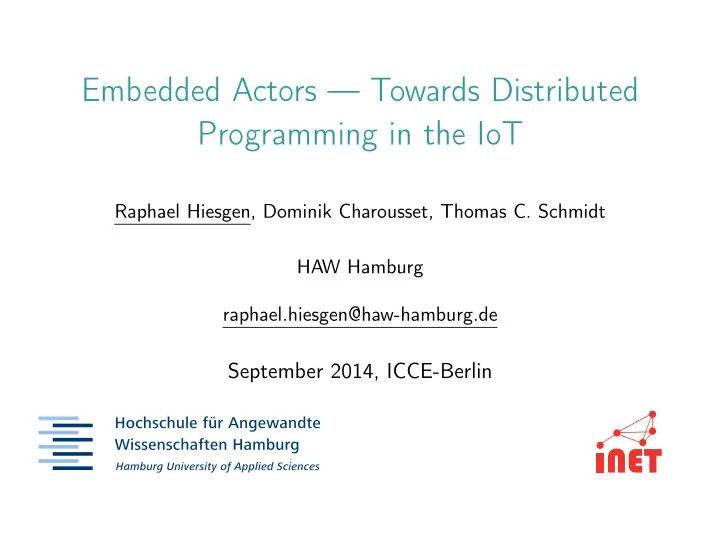

Embedded Actors — Towards Distributed Programming in the IoT Raphael Hiesgen, Dominik Charousset, Thomas C. Schmidt HAW Hamburg raphael.hiesgen@haw-hamburg.de September 2014, ICCE-Berlin
Agenda 1 The Internet of Things (IoT) 2 The Actor Model 3 Communication in the IoT 4 Messaging Architecture 5 Evaluation 6 Conclusion & Outlook Raphael Hiesgen iNET – HAW Hamburg 2
The Internet of Things (IoT) Characteristics Cooperatively process complex duties Dependent on machine-to-machine communication Connected to the Internet Implemented with networking standards Often constrained environment Developing for the IoT Fall back to low-level programming Hand-crafted network code Barely portable code ⇒ Raise the level of abstraction through the actor model Raphael Hiesgen iNET – HAW Hamburg 3
Agenda 1 The Internet of Things (IoT) 2 The Actor Model 3 Communication in the IoT 4 Messaging Architecture 5 Evaluation 6 Conclusion & Outlook Raphael Hiesgen iNET – HAW Hamburg 4
The Actor Model Isolated, concurrent software entities: actors Network-transparent message passing Divide & conquer via “spawn” Strong, hierarchical failure model Re-deployment at runtime Raphael Hiesgen iNET – HAW Hamburg 5
Limitations Actors not yet established in the native programming domain Need to broaden range of applications Deploy actors in performance-critical systems Actors not available for embedded systems Why not model the “Internet of Things” as network of actors? HW platform should not dictate programming model Raphael Hiesgen iNET – HAW Hamburg 6
The C++ Actor Framework The C++ Actor Framework ( CAF ) is an C++11 actor system Previously named libcppa Efficient program execution Low memory footprint Fast, lock-free mailbox implementation Targets both high-end and low-end computing Multi-core & many-node systems 1 Embedded HW, e.g., running 1 http://www.riot-os.org Raphael Hiesgen iNET – HAW Hamburg 7
Memory Usage 3500 25th percentile 75th percentile 1st percentile 99th percentile 3000 x x 2500 Resident Set Size [MB] Mean Median 95th percentile 5th percentile 2000 1500 1000 500 0 CAF scala erlang Raphael Hiesgen iNET – HAW Hamburg 8
Agenda 1 The Internet of Things (IoT) 2 The Actor Model 3 Communication in the IoT 4 Messaging Architecture 5 Evaluation 6 Conclusion & Outlook Raphael Hiesgen iNET – HAW Hamburg 9
Communication in the IoT Loosely coupled Unreliable links Infrastructure failure Challenges Error propagation for non-hierarchical systems Secure and authenticated connectivity Multiple open standards available to meet these challenges Raphael Hiesgen iNET – HAW Hamburg 10
Standards for the IoT Bluetooth low energy Supported by all major OSs IEEE 802.15.4 WPAN for embedded devices 127 bytes frame size IPv6 over Low-Power Wireless Personal Area Networks (6LoWPAN) IPv6 compatibility Header compression UDP / Datagram Transport Layer Security (DTLS) Features of TLS with datagrams Reordering, retransmission and fragmentation for the handshake Constrained Application Protocol (CoAP) Request-response model adapted from HTTP Works asynchronously over datagram protocols Offers reliability through Confirmable messages (CON) Raphael Hiesgen iNET – HAW Hamburg 11
Agenda 1 The Internet of Things (IoT) 2 The Actor Model 3 Communication in the IoT 4 Messaging Architecture 5 Evaluation 6 Conclusion & Outlook Raphael Hiesgen iNET – HAW Hamburg 12
CAF Network Stack C++ Actor Framework CoAP TCP DTLS UDP IPv4 / IPv6 6LoWPAN Ethernet / WLAN 802.15.4 / Bluetooth LE Raphael Hiesgen iNET – HAW Hamburg 13
Messaging Architecture Between Actors Map CoAP messages to CAF Reliability (CON) → synchronous messages Unreliability (NON) → asynchronous messages Handle small frame sizes Compress meta-information to slim down headers Type-exchange & annotation introduces more state Fragmentation on the application layer (CoAP block messages) Concept for error-propagation No longer connection oriented Based on asynchronous transactions (CoAP) Take unreliable messages into account Raphael Hiesgen iNET – HAW Hamburg 14
Agenda 1 The Internet of Things (IoT) 2 The Actor Model 3 Communication in the IoT 4 Messaging Architecture 5 Evaluation 6 Conclusion & Outlook Raphael Hiesgen iNET – HAW Hamburg 15
Packet Flow Evaluation Proof-of-concept implementation Network stack composed of Ethernet, UDP and CoAP Based on libcoap 2 Bitrate & message count compared to TCP based impl. Raspberry Pi sends 10 bytes to a desktop PC every 100 ms Characteristic scenario for sensor nodes Trace network traffic (handshakes, ACKs, messages, ...) 2 http://libcoap.sourceforge.net Raphael Hiesgen iNET – HAW Hamburg 16
Packet Flow CoAP + UDP 120k TCP 100k 80k Bit rate (bit/s) 60k 40k 20k 0 0 500 1000 Time (ms) Raphael Hiesgen iNET – HAW Hamburg 17
Packet Size Distribution CoAP + UDP 20 TCP 15 Count 10 5 0 0 20 40 60 80 100 120 140 160 180 200 220 240 260 Packet Size (bytes) Raphael Hiesgen iNET – HAW Hamburg 18
Agenda 1 The Internet of Things (IoT) 2 The Actor Model 3 Communication in the IoT 4 Messaging Architecture 5 Evaluation 6 Conclusion & Outlook Raphael Hiesgen iNET – HAW Hamburg 19
Conclusion & Outlook Development for the IoT requires specialized knowledge Network communication & synchronization Port software to different hardware The actor model abstracts over distributed systems Adjusted the CAF network stack to the IoT Proof-of-concept with first measurements Future work Concept for error-propagation Additional CoAP drafts (CoCoA, block messages, ...) Evaluation of packet loss, message sizes Adaption to RIOT Raphael Hiesgen iNET – HAW Hamburg 20
Thank you for your attention! Website: http://actor-framework.org Sources: https://github.com/actor-framework iNET working group: http://inet.cpt.haw-hamburg.de Raphael Hiesgen iNET – HAW Hamburg 21
Recommend
More recommend